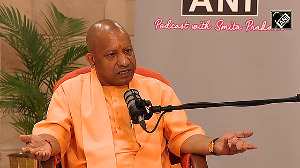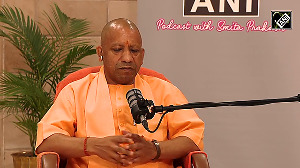'It might get worse. We don't really know what is it that is resulting in the high value of R now.'

You may not be able to treat epidemics with mathematics.
But you can certainly fight epidemics with math.
COVID-19 too.
Ever since the epidemic began, in a science lab in Chennai, Professor Sitabhra Sinha has donned a white coat to combat COVID-19 by manipulating numbers and statistics to second-guess the course the devious virus will take in India and its speed.
A professor of Computational Biology and Theoretical Physics at the Institute of Mathematical Sciences, Chennai, Professor Sinha, who has a special interest in applications of statistical physics to the analysis of socio-economic phenomena, earned his doctorate from the Indian Statistical Institute, Kolkata.
He has worked at the Indian Institute of Science, Bangalore and the Weill Medical College of Cornell University, New York.
As a member of the Indian Scientists Response to COVID-19 team, Professor Sinha has been observing the spread of the COVID-19 pandemic ever since it touched our shores early this year.
Being scientists and mathematicians, for Professor Sinha and his colleagues estimations of the growth/shrinking rates of the epidemic across India comes from studying the disease's crucial R value, that all-informative, all-important effective reproduction number that is a method of determining COVID-19's capacity to spread (external link), judging by how many people, on an average, a single infected person can transmit the virus to.
By looking at the incidence data for India as a whole, the states and for the major cities, they then try to quantify the rate at which the active number of cases is evolving by examining the reproduction number and discover how the number of active cases is going to grow or shrink, through short-term forecasts or nowcasting.
At the same time this statistical analysis, which is based on assumptions, gives an indication of how the pandemic is evolving across the country in what Professor Sinha terms as a "heterogenous fashion."

"Until about August, there was a steady decline in R, possibly because of the strict implementation of the social distancing measures and other measures, which had been put in place."
Around mid-August Professor Sinha says R measured to be around 1.05, on an average across India, much lower than the 1.83 it began at in March.
When R becomes 1 it essentially indicates plateauing because it means the number of new cases that are arising is exactly balanced by the number of recoveries - one for one.
And if R falls below one, that's even better news.
It shows that people are recovering at a rate faster than new infections are occurring.
"If you can maintain R less than one for a sustained period of time, effectively you can contain the epidemic," Professor Sinha tells Vaihayasi Pande Daniel/Rediff.com.
But the reverse would be disastrous and R shoots up to a value much greater than one.
The epidemic will keep growing and mushrooming, if even more people are getting infected per day than are recovering.
Using similar calculations, if no measures are taken to contain the epidemic, the fraction of the total population that will be affected, works out close to 60 per cent of India's population, he says.
"It's only when the total number of infected people comes to do some kind of a significant fraction of that, that we could see the natural tapering off of the epidemic."
Looking at the present case statistics it is evident that the epidemic has so far just "barely scratched the surface" given that approximately only 0.33 per cent Indians have been infected till date (a percentage of total cases of 4.6 million against our 1.3 billion population).
You can contrast that with World No 1 America where 2 per cent Americans are already infected.
"Given that we are nowhere close to that (60 per cent) and R went down from 1.83 to 1.05, around mid-August, it means that all the containment measures which were put in place were responsible for this decline."
Although at the moment he says R is around 1.09.

If R remains unchanged we would most probably see India breach a million active cases by the middle of this month - just after Sept 15 or so. Kind courtesy Professor Sitabhra Sinha
Professor Sinha says that the report card for different parts of India is constantly changing.
Delhi is a case in point. Till end it had managed to keep its R less than one.
"It looked for a while that by mid-September or so, they would have their active case count in the hundreds."
But the landscape quickly changed when by August 2, Delhi's R went above one and ever since then they have not been able to take it back down.
"At present it's actually quite high. I believe it's about 1.2 or thereabouts." While India is at the moment about 1.09."
Some states, who were in the top dozen, are still doing better.
Tamil Nadu and West Bengal have succeeded in getting their R value below one.
But they need to take heed of what happened in Delhi and it is critical that they sustain it.
Maharashtra and Uttar Pradesh have shown a marginal increase in their R values recently.
Maharashtra has unfortunately been consistently in the top two states in the state ranking of active cases.
"Whenever we saw the India R value tipping (lower), you could see that it was primarily contributed by any drop in the figure for Maharashtra."
That said Maharashtra has worked hard to lower its R value some.
So, while there is definite progress, its figures are not ideal.
The red herrings have been Chhattisgarh and Odisha, which out of nowhere joined the top dozen states club.
Chhattisgarh is ninth in the list of states with the highest active case count.
Professor Sinha says Chhattisgarh went completely below the radar.
"They started with a very small active case count. Sometime around early July, the effective reproduction numbers suddenly spiked to something like 1.36 or thereabout -- very high compared to the India-wide average."
"The number of active cases was actually, magnitude-wise, very low -- we weren't paying too much attention to it. But they had a very high value of R which was maintained for a fairly long time. Essentially, it maintained at 1.35 or thereabouts through the whole of August, which is the reason why they have a large number of cases at the moment there."
Assam also had a sudden spurt in between.
But it has "kind of steadied itself but has a pretty high active case count because of this sudden spurt in R."

Until about August it was primarily the cities which were driving the large active case counts, says Professor Sinha.
If you looked at it, state-wise, it was districts with large cities that were driving up a state's count.
In Tamil Nadu it was mostly Chennai and its neighboring districts, Kanchipuram and Madurai, which were contributing to the state's high R value.
In Maharashtra it was Mumbai, Pune and surrounding districts of Mumbai.
In West Bengal it was Kolkata and nearby North 24 Parganas and in Telangana it was largely because of Hyderabad.
"When states like for example, Chhattisgarh and Odisha start coming up in a big way on the list of states, it means that the pandemic focus has kind of shifted from the big metros to maybe middle-tier towns and possibly rural areas."
He wouldn't go so far as to say that the rural areas were/are at any point driving the pandemic, he says.
"We always see, for example, in states like Bihar, Jharkhand, whenever they come up, it's for very short periods of time. They have extremely high values of R, but then within a few days that kind of dies out.
Bihar and Jharkhand fall in a different basket of states because "the typical trend in these kinds of states, without major metropolitan cities, is the rises come in brief bursts. They have one week of extremely high R value. Following that R will quickly fall and the active case count will actually reflect this. The large value fall means that the active case count will shoot up for a while, but then when R falls back, it will again start slowing. You see this series of growth spurts and collapses."
In rural areas, or states with less dense urban population, when case numbers falls after a spike, "not having actual information about the kind of containment measures (put in place), it's very hard to say whether it's because of containment effects taken by the district administration or there's a natural kind of fizzling out."
Natural fizzling out, Professor Sinha says is possible because in order for the disease to flourish, it needs to find susceptible individuals ie warm bodies.
"That's actually one of the reasons why COVID-19 grows much faster in urban areas where there's a high density of population than in rural areas where the local population density is much lower."
"If you have a scenario where the disease is propagating in a relatively sparse population, where transportation is not readily available, so that people, who are already infected, cannot travel across large distances and inadvertently infect people in other areas, you would naturally have some increases, where the disease is going to quickly spread among the local population. But because it can't travel beyond the capabilities of the transportation system at that point, it will essentially exhaust itself and then just die out."

Areas, cities or states are often successful in getting their R below one.
But another cluster of the disease is all you need to have and R will go up again.
Professor Sinha cites the example of the Coimbatore cluster in Tamil Nadu, which caused a huge spurt sometime in May or June.
"All that happened was essentially, in this wholesale market, a group of people were infected by the disease. They had come from different parts of the state and when they went back, they essentially helped spread the disease to quite a large number of districts.
"Some kind of event like that, and it's very hard to control it, if you allow people to move relatively freely. The moment such events happen, you would have fresh epicenters of the epidemic arising in different parts. You'd have to go all out to contain each of these.
The appearance of cluster is, he says "quite inevitable" if the authorities start relaxing their stricter checks on movement of people.
It is also a question of luck too. "All you need is something like the Coimbatore cluster emerging to kind of wipe out the gains of several weeks of containment."
 IMAGE: Professor Sitabhra Sinha
IMAGE: Professor Sitabhra SinhaSince, while making assessments of the spread of COVID-19, there's a real possibility that they are not getting the all the cases, Professor Sinha says, "That's why we estimate not the total case count, but rather the growth rate. Because the growth rate is essentially a proportion, right. It's basically asking -- given that you have this many known cases -- how many other people are going to get infected.
He adds, "Presumably your testing rate would not change overnight so that you would also have a very similar proportion of undetected cases at a future point of time. Assuming that you have drastically changed your testing criteria within a short period of time, the growth rate is going to be unaffected, because essentially the proportion of people you're missing would be consistent at different time points. So that's why we use this much more robust measure."

When and if an effective vaccine, comes out it will halt the march of the pandemic.
How many people need to be vaccinated for that to happen?
"Once the vaccine is given to enough number of people -- which also one can estimate from the R value ie what proportion of population do you need to give the vaccine to -- of course, you are you will be preventing a recurrence of the epidemic."
But in the absence of a vaccine, he says the only way to ensure that the epidemic is going away is just to "let it play out."
That philosophy did not work in Sweden where they thought they would allow the epidemic to "run its natural course".
But the furor caused by an extremely high death rate among the elderly forced that country's authorities to quickly change their policies.
In absence of the vaccine, Professor Sinha says, "The continuing measures while they have not killed the epidemic, have managed to keep the epidemic burden to manageable levels, where at least it's not causing our health infrastructure to collapse. We've certainly have not seen, the kind of chaos that we saw in Italy and Spain in March and April. Yes and New York, exactly."
This in effect has prevented drastic "upswing of the epidemic" and bought India a few benefits.
"But I think everybody agrees that the kind of containment measures that succeeded in getting R down to 1.05 are simply not sustainable. If you want people to go back to life as it was it's simply not possible to keep doing this indefinitely."
Professor Sinha says India has to make a call on "whether we should keep waiting for the vaccine and in the meantime, at least, allow certain containment measures to be still kept in place. Or do we just let people go back to their ways and allow the epidemic take its natural course?"

When active case counts were not growing that high because the R value was close to 1.05, COVID-19 didn't look like what it was predicted to be in spite of the "alarming projections of how many deaths we will see."
That, Professor Sinha says could have cause people to become complacent and feel that the disease assessments were all "hyped up" and lose their guard quickly.
But it didn't.
"We also have to take into account the fact that, to some extent, we didn't see those extremely high number of deaths because of the fact that people took precautions and there were containment methods which were put in place.
He explains further: "Let me also put it this way: After the announcement of the Unlock Phase 1 and Phase 2, I was expecting to see R climb to a very large value from what it was at that time. It was that time around 1.15 or thereabouts. I was expecting that within two weeks of phase two, it will go back to 1.4 or 1.5 or thereabouts. When it didn't -- in fact, it decreased after that -- I was actually very surprised this happened."
There was only one possibility why this happened, he reasoned: "People were -- even though they were not forced to do it -- adapting good practices like wearing face masks, maintaining some degree of physical distance with each other."
The increase in R has come quite some time later. "For me, the big surprise was why we didn't show a much higher value of R even earlier. If we hadn't taken those measures, definitely the number of deaths would have been much higher."
A higher R value has come now, after a delay and that is part of the cycle of the disease given there has been a loosening of containment measure.
Is it probably going to get worse? "It might get worse. We don't really know what is it that is resulting in the high value of R now."
The actual effective reproduction numbers obtained with data upto September 7 for India, as well as for the top dozen or so states in terms of current active cases. Kind courtesy Professor Sitabhra Sinha.
Feature Presentation: Ashish Narsale/Rediff.com












 © 2025
© 2025